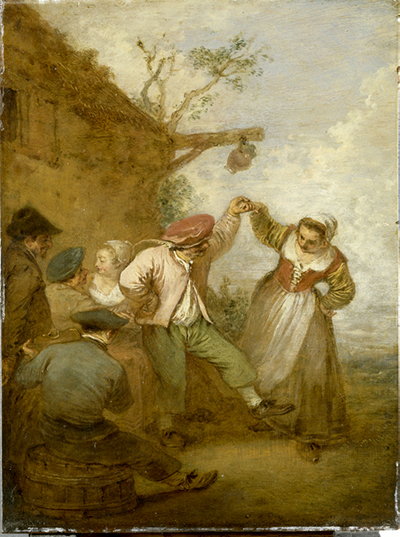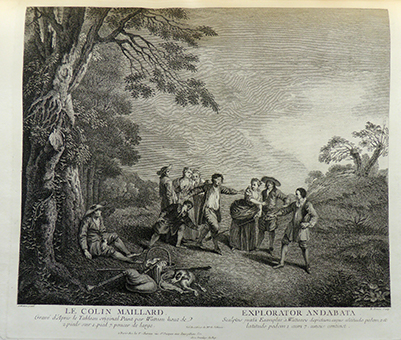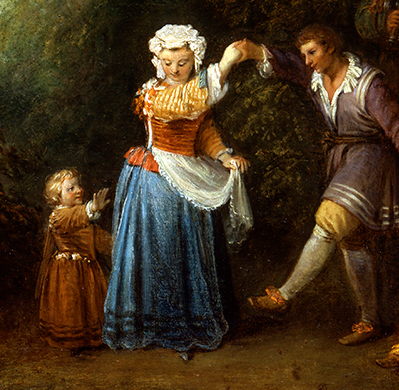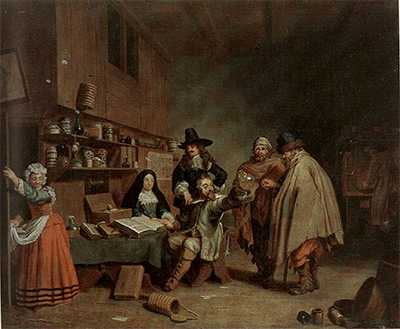
- Home Page
- Accepted
Paintings & Copies - Doubtful
Attributions - Doubtful Textual References
- Alternative
Titles - Collectors &
Museums - Bibliography
- Search Abecedario
- Watteau &
His Circle
La Danse champestre
Entered November 2019
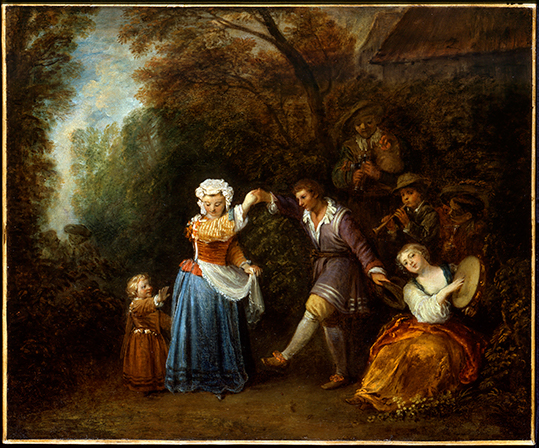
Indianapolis, Indiana, Indianapolis Museum of Art at Newfields, inv. No. 74.98
Oil on canvas
49.5 x 60 cm
ALTERNATIVE TITLES
The Country Dance
Danza campestre
RELATED PRINTS
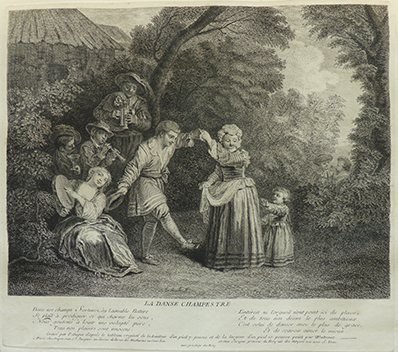
Pierre Dupin after Watteau, La Danse champestre, engraving, c. 1730.
Watteau’s La Danse champestre was engraved by Pierre Dupin at some time around 1730.
PROVENANCE
Southern France, private collection,
New York, with Wildenstein & Co., New York (See letter from Louis Goldenberg of Wildenstein & Co. to George D. McKee, dated August 26, 1976, in Indianapolis Museum of Art Historical File; 74.98). Sold to Max Safron.
New York, Max Safron Galleries. Bought by Josiah K. Lilly Jr. in 1961.
Indianapolis, collection of Josiah K. Lilly Jr. (1893-1966; pharmaceuticals), Indianapolis, in 1961.
Elinor (Mrs. Herman C.) Krannert (1890-1974; widow of industrialist and philanthropist).
Donated to the Indianapolis Museum of Art in 1974.
EXHIBITIONS
Hanover, Hood Museum, Intimate Encounters (1997), cat.no. 1 (as Watteau, The Country Dance, lent by the Indianapolis Museum of Art).
SELECT BIBLIOGRAPHY
Goncourt, L’Art au XVIIIème siècle (1860), 58.
Goncourt, Catalogue raisonné (1875), cat. 185.
Dacier, Vuaflart, and Hérold, Jean de Jullienne et les graveurs (1921-29), cat.
170.Réau, “Watteau” (1928), cat. 79.
Adhémar, Watteau (1950), cat. 4.
Mathey, Watteau, peintures réapparues (1959), 66.
Eidelberg, Watteau’s Drawings (1965),
Macchia and Montagni, L’opera completa di Watteau (1968), cat. 5.
Janson and Fraser, 100 Masterpieces of Painting (1980), 124-27.
Roland Michel, Watteau (1981), cat. 5.
Tomlinson, La Fête galante (1981), 29.
Posner, ”Watteau’s Country Dance” (1983-84), 27-31.
Roland Michel, Watteau (1984), 211, 306.
Posner, Watteau (1984), 15, 18, 20, 21, 160.
Edwards, “Watteau and the Dance “ (1987), 221-22.
Cohen, Watteau’s ‘Fête galante’ (1988), 154.
London, Leger Galleries, British Painting (1989), cat. 10.
Wyngaard, From Savage to Citizen (2004), 63-64.
RELATED DRAWINGS
No drawings are associated with La Danse champestre.
REMARKS
Were it not for Dupin’s engraving, would we so readily accept its attribution to Watteau? Certainly the painting has not fared well, and critics have noted this in order to explain its appearance, which falls short of the quality we would normally expect from a Watteau painting. Also, the painting’s faults have been attributed to its supposed early date, and the very Flemish subject and style are ascribed to his upbringing in Valenciennes. The dates that have been proposed for this picture vary but not considerably: Adhémar considered it to be among Watteau’s earliest known paintings, dating it c. 1702. Macchia and Montagni placed it c. 1703; Wyngaard proposed before 1705; Mathey proposed a date of c. 1704-05; Roland Michel preferred 1705/06; Posner suggested c. 1705-10; Rand opted for 1706-10. Despite the different years that have been proposed, there is common agreement that it is among the first paintings he executed after his arrival in Paris.
There are several other Watteau paintings with Flemish themes and a markedly Flemish style. They all are assumed to represent his juvenilia, including La Vraie gaiété, Le Colin maillard, and Le Retour de guinguette. They share in common similarly stumpy bodies and awkward, jerky movements.
There is a specific but problematic link between Watteau’s La Danse champestre and Flemish painting. As has been pointed out elsewhere, the dancing woman in Watteau’s picture corresponds to an identical figure in a painting ascribed to the genre painter Jan Joseph Horemans the Elder (1682-1759), although the attribution may be open to question. The painting was sold in London at Sotheby’s, June 15, 1983, cat. 58. Given that the two artists were contemporaries, the question is which way the influence flowed. It may be that Horemans was inspired by Watteau or, given the reversal of direction, that he turned to Dupin’s engraving.
Click here for copies of La Danse Champestre
